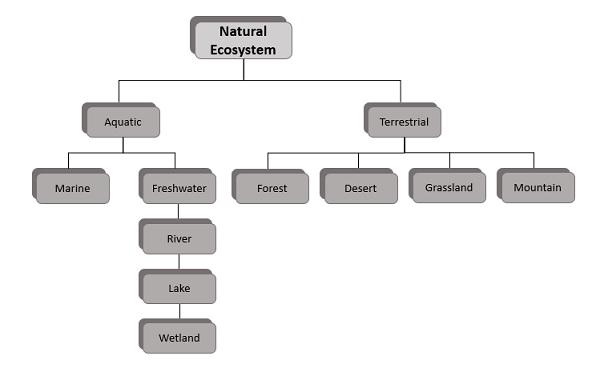Summary
Ecosystems fall into many types and are classified based on a number of factors. The paper will be concentrated on the main types of ecosystems and try to understand the basis on which these classifications are made. It is also essential to know the different factors that distinguish ecosystems from each other. Ecosystems can usually be divided into two classes, such as natural and artificial. Artificial ecosystems are natural areas influenced by humans. These are man-made lakes, bodies of water, settlements, and cities (Delgado & Marín, 2020). Natural ecosystems are basically divided into two main types. They are the aquatic ecosystem and the terrestrial ecosystem.
Biotic components in ecosystems include organisms such as plants, animals, and microorganisms. Biotic features of an ecosystem include autotrophs, heterotrophs, and detritus. The abiotic components consist of climate or climatic factors such as temperature, light, moisture, precipitation, gases, wind, water, soil, salinity, substrate, mineral, topography, and habitat (Delgado & Marín, 2020). The flow of energy and the cycling of water and nutrients are critical to every ecosystem on Earth. The non-living components provide the basis for ecosystem function. The picture here shows the ecosystems and their classification.

Aquatic ecosystem
An ecosystem that resides in a body of water is known as an aquatic ecosystem. The nature and characteristics of communities of living or biotic organisms and non-living or abiotic factors that interact and interrelate with each other are determined by the aquatic environment of the environment on which they depend. An aquatic ecosystem can be broadly divided into a marine ecosystem and a freshwater ecosystem.
Marine ecosystem
These ecosystems are the largest of all ecosystems because all the oceans and parts of them are included. They contain salt marshes, littoral zones, estuaries, lagoons, mangroves, coral reefs, deep sea, and seafloor. The marine ecosystem has unique flora and fauna and supports a vast realm of species. These ecosystems are essential to the overall health of both the marine and terrestrial environments (Delgado & Marín, 2020). Salt marshes, algae meadows, and mangrove forests are some of the most productive ecosystems. The coral reef provides food and shelter for the most significant number of marine life in the world. The marine ecosystem has incredible biodiversity.
Freshwater ecosystem
The freshwater ecosystem includes lakes, rivers, streams, and ponds. Lakes are large bodies of freshwater surrounded by land. Plants and algae are essential to the freshwater ecosystem because they provide oxygen for photosynthesis and forage for animals in this ecosystem. Estuaries are home to plants with a unique ability to survive in fresh and salty environments. Mangrove forests and pickleweed are examples of estuary plants (Delgado & Marín, 2020). Many animals live in the freshwater ecosystem. Freshwater ecosystems are essential to people because they provide them with water for drinking, energy and transportation, and recreation.
Terrestrial ecosystem
Terrestrial ecosystems are ecosystems that exist mostly on land and are used for survival. Water may be present in a terrestrial ecosystem, but only partially, as they are mainly located on land. These ecosystems come in different types, such as forest ecosystems, desert ecosystems, grassland ecosystems, and mountain ecosystems. Terrestrial ecosystems differ from aquatic ecosystems in their lower water availability and the resulting importance of water as a limiting factor. They are characterized by more significant fluctuations in temperature during both daytime and seasonal times than aquatic ecosystems under similar climatic conditions (Delgado & Marín, 2020). Light availability is higher in terrestrial ecosystems than in marine ecosystems because the atmosphere is more transparent on land than in water. Differences in temperature and light availability of terrestrial ecosystems reflect various flora and fauna.
Reference
Delgado, L. E., & Marín, V. H. (2020). Ecosystem services and ecosystem degradation: Environmentalist’s expectation? Ecosystem Services, 45, 101177.